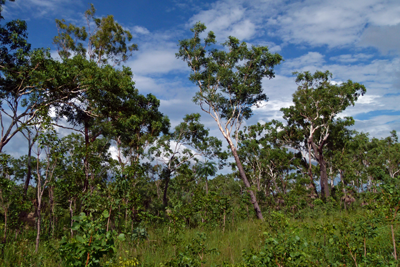Woodlands
 Ian Morris
Ian Morris
The woodlands of North Australia are one of the largest areas of "reasonably intact" natural systems remaining in the world. It covers the vast majority of the Top End, extending across the top of Queensland right through to the Kimberley in Western Australia. As an example 75% of Kakadu is woodland. The habitat is made up of a mix of trees, shrubs and grasses, with the composition of these species - the vegetation structure - and therefore the habitat, changing depending on the soil type and depth and moisture availability in a particular area.
The most common and largest trees of the woodlands are the Eucalytps, with the Darwin Woollybutt (Eucalyptus miniata) and the Darwin Stringybark (Eucalyptus tetrodonta) being the most prevalent. Bloodwoods, or corymbias as they are now known, are less common, but also grow large like the eucalypts to make up the canopy layer. Acacias, grevillias and a number of smaller tree species such as the Billy goat or Kakadu Plum (Terminalia ferdinandiana) and the Green Plum (Buchanania obovata) make up the bulk of mid and understory species. In some locations where conditions are right there are also stands of small sand palms and "palm like" cycads to make up the lower stories. These plants can come dominate the lower stories completely on ideal soil, and the woodland is comprised of only them and great eucalypts towering far overhead. The dominant grass of the woodlands is speargrass which grows to well over two metres in height.
The activity of earthworms and termites are important in the cycling nutrients through the poor soils of the woodlands. Termites act as the major primary consumers in woodlands, and perform the role that large herds of herbivores perform in other continents. They are also vitally important as a food source for many of the animal species and so are vitally important to woodland foodwebs.